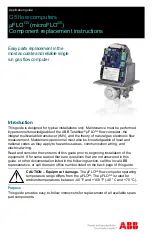
Operation - Stream Configuration
Fusion4 MSC-L
Part No.: 4418309_Rev09
5 - 158
Installation & Operation Manual
Honeywell
5.14.1.4.2.2 MPMS 11.1 (D1250-04), Commodity Group C (Special Applications)
For volume conversion, this commodity group requires knowledge of
the thermal expansion factor
60
. The product density data is not
necessary for volume conversion for cases where compensation for
pressure effects is not required, but the density is still needed for
product mass determination. It is recommended always to configure
appropriate product density (or use the density sensor).
Valid ranges for this commodity group are specified in MPMS 11.1 (see
table above).
5.14.1.4.2.3 MPMS 11.2.4 (TP27-07), Commodity Group E (NLG & LPG)
The calculation of the pressure conversion factor is not included directly
into the MPMS 11.2.4 (TP27-07) procedures, therefore MPMS 11.2.2
and product vapour pressure are used in addition for calculating the
compressibility of the fluid. Iterative process is used in this case to
establish density at reference conditions, which in turn is used to derive
CTPL (VCF).
The product vapour pressure source can be configured as:
Calculated - using MPMS 11.2.5 standard
Measured - directly measured by configured pressure sensor
Externally controlled - in this case the product pressure Pm is
controlled externally to be above equilibrium (vapour) pressure Pe by
fixed safety margin Ps, therefore Pe = Pm - Ps
NOTE: In configurations where compensation for pressure
effects is used together with density input (or labo
-
ratory pressure is non-zero) and such compensation
is not an integral part of the commodity group
standard (currently it applies to TP27-07 and CNP6-
70 commodity groups), some combinations of
measured parameters (typically at high pressures)
can have multiple theoretical solutions for the
product density at base conditions. In such case,
MSC-L will resolve to one of these roots – typically
such roots would be close to each other having minor
effect on overall CTPL (VCF) calculation results.
Sometimes the containment vessel for the product contains means of
altering the vapour pressure in the vessel to some value other than the
equilibrium pressure (Pe) at the metering temperature (Tm). The
difference between the calculated equilibrium pressure at the observed
temperature and the actual measured pressure (Pm) in the vessel
results in a pressure difference (
P) that is then used for calculating the
compressibility factor (Fp) of the product at the observed conditions
using MPMS 11.2.2. Finally, the compressibility factor and the pressure
differential between the observed pressure and the equilibrium vapour
are used for calculating the CPL for blend product.
















































